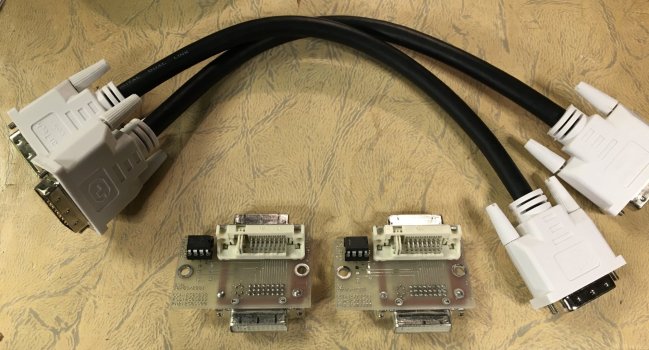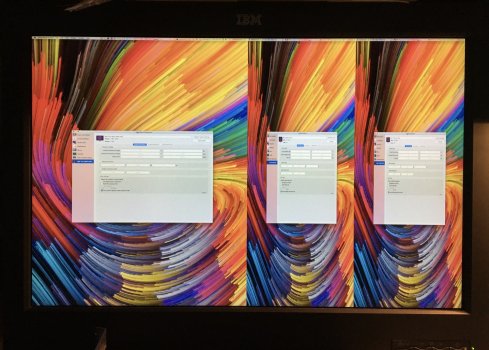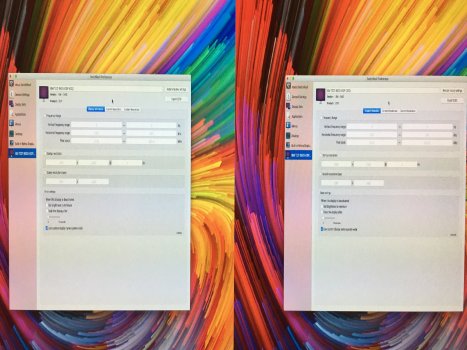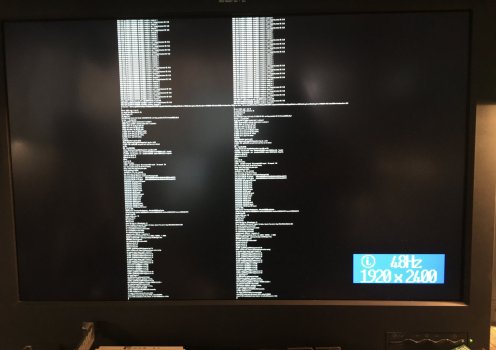Yeah, and 4.3.6 on the 2008 (10.6.8)SwitchResX 3.8.7 on Tiger (10.4.11) I presume?
That's a good point. I should remove the override before I plug it in next time in case it's failing to send 452.24 MHz.That's curious. Does it not work with the TH2G-SE at all, or not at >360 MHz?
Maybe a combination of both options. Monet, Roentgen, the T210, and CDU2510A appear to exist in the same 'storyboard' so to speak, but the uncommonness of any 'Quad' derived XGA resolutions kind of merits mentioning all 2048 x 1536 and greater resolution support, at least for displays predating DisplayPort. The modern displays which are clearly of the DP age but use multiple DVI links anyways are kind of in a weird zone.In that case, I'd list only prototypes, close siblings and offshoots (and Toshiba's TN version), to avoid cluttering up the page.
This would make sense if the 3280×2048 and 4096×2560 (16:10) medical displays were also included.
This tablet might also be worth mentioning because of its display (20" 3840×2560; 3:2; 230 ppi) and HDMI 2.0 input (2015 model only). On the other hand, it’s quite recent (introduced in 2013) so may not fit the bill. For me, it’s about ultra-high-res displays that were way ahead of their time.
I'd appreciate taking a look. The odd numbered vertical resolution makes me think this is a total image signal including the intervals.A 22" IBM display with a resolution of 3548×2661 (4:3) is mentioned in a late-2000 issue of German computer magazine c’t (c’t 24/2000, page 62). It's behind a paywall, but I can make it available. I couldn't find anything about this display, so I guess they may have been talking about Bertha but got the resolution wrong. Or maybe......
Shooting completely from the hip, supposing IBM was using the same approach as is evident in Bertha's EDIDs:
Using GTF to determine the vertical intervals and custom definitions for horizontals, considering a target somewhere in the 40-60Hz range for four stripes would give 2661 at
around 38.0 Hz for 2604 (perfect 4:3)
around 41.0 Hz for 2600
around 42.5 Hz for 2598 (perfect 4:3)
around 54.5 Hz for 2580 (perfect 4:3)
around 68.0 Hz for 2560
But there's the issue of 3548. If it's a four stripe configuration it would require an odd numbered horizontal total. If it's a four tile it could use an even horizontal, but then would require inequal vertical totals for 2661. Assuming the former:
((3548/4)-(8+32+23))*4 = 3296 (824 x 2472 @ 4:3; too small for vertical GTF unless 128.5 Hz; 297 MHz)
((3548/4)-(8+32+15))*4 = 3328 (832 x 2496 @ 4:3; too small for vertical GTF unless 112 Hz; 262 MHz)
((3548/4)-(8+32+7))*4 = 3360 (840 x 2520 @ 4:3; too small for vertical GTF unless 95.5 Hz; 225 MHz)
The horizontal totals are bordering on implausible, so I'm not sure this is at all close.
Doesn't seem like this approach works unless I'm off by a factor of two for some reason. Those total timings are plausible for single link stripes if cut in half...
On Bertha's 'custom' timing modes, the vertical intervals aren't straight GTF, only similar to GTF totals. So I could be going wrong there...
Could also just be an LCD die cut at 3548 x 2661
Using GTF to determine the vertical intervals and custom definitions for horizontals, considering a target somewhere in the 40-60Hz range for four stripes would give 2661 at
around 38.0 Hz for 2604 (perfect 4:3)
around 41.0 Hz for 2600
around 42.5 Hz for 2598 (perfect 4:3)
around 54.5 Hz for 2580 (perfect 4:3)
around 68.0 Hz for 2560
But there's the issue of 3548. If it's a four stripe configuration it would require an odd numbered horizontal total. If it's a four tile it could use an even horizontal, but then would require inequal vertical totals for 2661. Assuming the former:
((3548/4)-(8+32+23))*4 = 3296 (824 x 2472 @ 4:3; too small for vertical GTF unless 128.5 Hz; 297 MHz)
((3548/4)-(8+32+15))*4 = 3328 (832 x 2496 @ 4:3; too small for vertical GTF unless 112 Hz; 262 MHz)
((3548/4)-(8+32+7))*4 = 3360 (840 x 2520 @ 4:3; too small for vertical GTF unless 95.5 Hz; 225 MHz)
The horizontal totals are bordering on implausible, so I'm not sure this is at all close.
Doesn't seem like this approach works unless I'm off by a factor of two for some reason. Those total timings are plausible for single link stripes if cut in half...
On Bertha's 'custom' timing modes, the vertical intervals aren't straight GTF, only similar to GTF totals. So I could be going wrong there...
Could also just be an LCD die cut at 3548 x 2661







